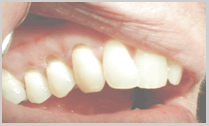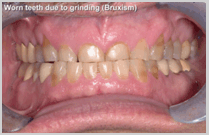2. Abrasion
 External agents which have an abrasive effect on the teeth include toothbrush bristles and dietary factors.
External agents which have an abrasive effect on the teeth include toothbrush bristles and dietary factors.  Bruxism (from the Greek βρυγμός (brugmós), gnashing of teeth) is the grinding of the teeth, and is typically accompanied by the clenching of the jaw. It is an oral parafunctional activity that occurs in most humans at some time in their lives. In most people, bruxism is mild enough not to be a health problem; however, 25% of people suffer from significant bruxism that will become symptomatic. While bruxism may be a diurnal or nocturnal activity, it is nocturnal bruxism which causes the majority of health issues, and can even occur during short naps. Bruxism is one of the most common sleep disorders.
Bruxism (from the Greek βρυγμός (brugmós), gnashing of teeth) is the grinding of the teeth, and is typically accompanied by the clenching of the jaw. It is an oral parafunctional activity that occurs in most humans at some time in their lives. In most people, bruxism is mild enough not to be a health problem; however, 25% of people suffer from significant bruxism that will become symptomatic. While bruxism may be a diurnal or nocturnal activity, it is nocturnal bruxism which causes the majority of health issues, and can even occur during short naps. Bruxism is one of the most common sleep disorders.